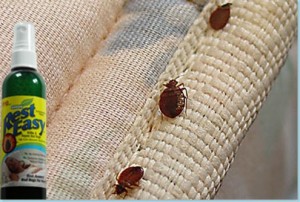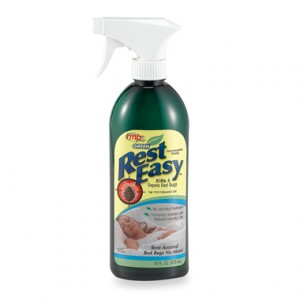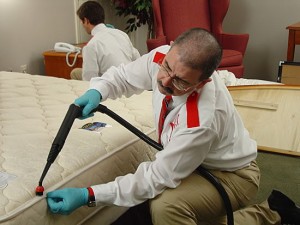

Removing bed bugs is easy but you have to see them in order to effectively get rid of them. Killing bed bugs can be tricky and costly if you call a professional exterminator (recommended) to get rid of them. They will often charge $300 - $600 to treat a single room. And they don’t always guarantee the results. You may want to attempt to remove and kill as many bed bugs as possible before calling in the professionals.
Below are a few things you can do to get rid of and kill bed bugs.
Home Remedy Option #1:
Isopropyl Alcohol
Effectiveness rating: 4/10
Isopropyl (rubbing) alcohol kills bed bugs on-contact. Find the surfaces bed bugs inhabit, including crevices and harborages. Mix the isopropyl alcohol at a 1:1 ratio in a spray bottle with water. Liberally spray the surfaces and crevices and allow to dry naturally. Less water is recommended for smaller areas or areas sensitive to water.
Home Remedy Option #2:
Heat
( Information on Heat used by Professionals to Kill Bed Bugs )
Effectiveness rating: 3/10
Many professional exterminators are now using heat to kill bed bugs. It’s safer and more effective than many of the chemicals traditionally used. Unfortunately the big commercial trailer-mounted BTU heating systems can cost up to $50,000.
A residential dryer can be effective for killing bed bugs on clothing, bedding materials, stuffed animals, shoes or any other soft articles which are “dryer-safe.”
When using the dryer, operate using small to medium size loads and run the dryer on high for at least 15 minutes. Remove the items immediately and seal them in a plastic bag for 24 hours. This will ensure that you kill all of the bed bugs.
Important: Please use your own dryer. Do not take the items to a laundromat or community dryer units. It is important to contain the infestations, and traveling with the items will only help spread the bed bugs and contaminate the other locations.
Home Remedy Option #3:
Steam
Effectiveness rating: 2/10
Steam cleaning is recommended for any surfaces infested with bed bugs. The problem is that many homeowners do not have access to adequate steam cleaning equipment. Heating unpressurized water to above 220-degrees will boil, so it’s important to make sure you proceed caution. Spray the infested surfaces with the steam, completely saturating the areas. Speed drying the surfaces is recommended to avoid damage or mold infestation to furniture or other articles.
As you can see, these options are a lot of work and are not very effective. However, if you can afford it, calling in the professionals is highly recommended!
Other Options and Additional Information
There are many insecticides that are available in both dust and spray applications. Some of the primary ingredients to look for when choosing something proven to combat bed bugs include permethrin, propoxur, chlorpyrifos, cyfluthrin, fencalerate, benseneacatate, and resmethrin. Most of these products are available in retail and hardware store.
Hydoprene is an insecticide that does not actually get rid of bed bugs outright, rather it works to sterilize adult bed bugs. While the process may take a bit longer it tends to ensure the eventual end of the infestation.
For a more organic approach you might consider the use of non-residual pyrethrin. This form of insect control is derived from the chrysanthemum flower and routinely kills insects on contact.
You must first locate where the bed bugs live. Remember, just because they are called bed bugs, doesn’t mean they can’t live in other areas of the home. Once the bed bugs are located, there are many control methods that may be used to combat the bed bugs.
Vacuuming all visible bed bugs from the mattresses and box springs and their other known dwellings is an effective removal option. Ensure the vacuum bag is removed, sealed, and disposed of immediately after the vacuuming process. Mattresses and pillows can be cleaned, paying particular attention to the seams and ribbing of the mattress, to kill any remaining bed bugs. Seal the mattress and box springs in plastic bags to make sure any missed bugs do not attempt to escape. Bed linens and drapes can be dry cleaned or wet washed with a cleaning detergent and bleach in hot water.
Many pesticides are available for use. But only one is approved for use on bedding (Unsmoke Microban). They should always be used in accordance with the manufacturers’ label. Insecticides can provide instantaneous results for active bed bug infestations and residual protection against future infestations.
Insecticides are classified by the application method: Crease and Crevice, Indoor Surface, Indoor Space, and Fumigation. It is important to know the differences between each category in order to utilize the most effective treatments.
Crease and Crevice application are for areas that are typically hidden or hard to reach. Granual pesticides and some wetsprays fall into that category. Granuals can be applied using either a puffer or a brush. Graqnuals are lighter and can penetrate further than insecticide wet sprays, therefore, they should always be used in places where with deep cracks and crevices. Granules are also preferred over wet sprays for treating the tufts, folds, and sleep surfaces of mattresses & bedding materials.
Indoor Surface treatment is for areas where the bugs are most likely to crawl en route to either their dwellings or to where they like to feed. This type of process is commonly referred to as residual treatments. They are designed to stay active for an extended period of time to ensure the effectiveness of the treatment. The sprays are to be applied to the bed frames and the non-sleeping surfaces of mattresses.
Drawers should be removed from dressers and flipped upside down, to ensure all surfaces are thoroughly sprayed. Spray wood and all walls at least 24 inches above the flooring for the entire room.
Indoor applications are used to kill bed bugs on contact. These insecticides are usually found in the form of aerosol sprays. When harborages are located, it’s recommended that you spray the insecticide in the air in the area toward the bed bugs.
Aerosols are recommended when treating materials like clothing or stuffed animals. These types of items can be placed into a plastic bag or a closet (which is also probably infested). Spray the aerosol into the closet or bag and close it for 10- 20 minutes.


How to Get Rid of Bed Bugs
Getting rid of bed bugs consists mainly of locating and thoroughly cleaning the areas where the bed bugs hide in during the daytime hours. Hiding spots can usually be found by looking for black or brown spots of dried insect fecal matter on various surfaces on which the bed bugs dwell.
Bed Bug eggs, egg shells and shed skins may also be found in dwelling areas. Early on during the infestation bed bugs are likely to be located only around the seams, tufts or crevices of mattresses or bed covers, but later they move to crevices in the bed steads. In a severe infestation bed bugs can be found behind base boards, window and door casings, pictures and picture frames, in sofas and furniture, ripped wallpaper & cracks in drywall and.
Management should focus on cleaning methods such as vacuuming, sealing loose wall surfaces, caulking cracks, and other dwellings. A thorough cleaning may need to be completed more than once because eggs may be missed, or bugs may be well hidden during the initial vacuuming. Vacuum the mattress, paying close attention to tucks and along seams. Be sure to dispose of the vacuum cleaner bag immediately after the cleaning.
After completing the cleaning process be sure the bed is moved away from any walls so that it does not make contact with them. Coating the bed legs for 3 to 5 inches with something to stop bed bugs from crawling up into the bed is typically recommended. Petroleum jelly is often used for this, but be sure to put something under the bed legs to collect any dripping. Remove all dust covers, and keep the bed covers and blankets off of the floor.
The services of a certified pest management company is often a good idea and may be needed in severe infestation situations.
If you decide to kill the bed bugs yourself, apply an insecticide that is specifically labeled for bed bug management. Apply to hiding places around base boards, door and wall moldings and floor boards. Caution: NEVER USE ANY INSECTICIDE ON A MATTRESS - unless the label specifically refers to application to a mattress. Most insect sprays are not registered for application to mattresses. People often opt rather to discard the mattress.
Use of Insecticides: (Not recommended for non-professional exterminators)
1. Spray the slots, springs and bed frame. Spray enough solution to wet thoroughly. Do not miss any areas where bedbugs might dwell or hide out.
2. Spray a light mist to the entire mattress. Open up the seams, tufts and folds. Material should always be completely dry before using it again.
List of pesticides labeled to get rid of bed bugs.
Allethrin
Delta Dust - 0.05% (deltamethrin)
Pyrethrins
Resmethrin - 0.3% spray
Suspend SC - 0.6% spray
Drione Dust
Flee/Dragnet FT - 0.5% spray
Malathion 57% EL - 4 table spoons per gal. of non-odor kerosene
Tempo 2 - 0.05 - 0.1% spray
Tempo 0.1% dust
Tempo 20 WP











